
When should courts defer to agency interpretations of statutes, and what measure of deference should agencies receive? Administrative law recognizes two main deference doctrines — the generous Chevron standard and the stingier Skidmore standard — but Supreme Court case law has not offered a bright-line rule for when each standard applies.
Many observers have concluded that courts’ deference practice is an unpredictable muddle. This Article argues that it is really a lottery, in the sense the term is used in expected utility theory. Agencies cannot predict which deference standard a court will apply or with what effect, but they have a sense for how probable the different possible outcomes are. This Article presents empirical support for the “deference lottery” hypothesis, and then conducts a simple game theory analysis to understand how judicial review bears on agency behavior in statutory interpretation under deference lottery conditions.
The Article concludes that, in fact, the deference lottery can function as a flexible tool for managing agency behavior. The lottery can curb agency opportunism by imposing a risk that agencies’ interpretations of statutes will face elevated scrutiny rather than Chevron deference. This analysis offers a new perspective on deference doctrine, and in particular on the Supreme Court’s Mead decision, which sets out the standard for when Chevron applies. Mead’s vagueness, widely derived as a bug, may in fact be a feature. Still, the deference lottery can backfire badly if Skidmore is applied too stringently, as the Article shows.
Available at: http://works.bepress.com/jud_mathews/5/
